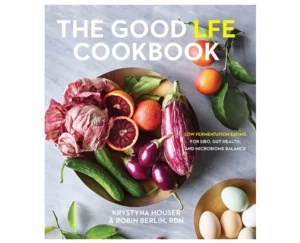
Until now, the only diets available for SIBO-sufferers were Low-FODMAP or the Elemental Diet. Both diets are highly restrictive and not meant to be sustained long-term.
Krystyna Houser is a longtime SIBO-sufferer who found remission through harsh diets and medical interventions, but wanted to find healthier, more sustainable solutions. She discovered the Low Fermentation Eating plan by Cedars Sinai gastroenterologists, Dr. Mark Pimentel and Dr. Ali Rezaie and experienced a dramatic change -- not only regaining her health, but also the ability to enjoy food and life again.
After her experience, Krystyna partnered with the doctors to create a seasonal cookbook filled with recipes that won't cause bloat and will aid in gut health. The Good LFE Cookbook is the first cookbook to showcase the "Low Fermentation Eating " or LFE diet protocol. The diet is less restrictive for SIBO-sufferers and introduces delicious eating options that are much easier to embrace everyday.
We asked Krystyna to walk us through her day on the diet below. First, Dr. Ali lays out the basics of SIBO for those who are unfamiliar...
What the Heck is SIBO?
Small intestinal bacterial overgrowth (SIBO) is a condition where excessive amounts of bacteria reside in the small bowel. SIBO is a form of dysbiosis where the balance of gut microbiome is lost. Small bowel is the main part of the GI tract to absorb food and nutrients. In SIBO patients, some of the food gets fermented by the excess bacteria which produce various side-products and gases including hydrogen, methane, carbo dioxide and hydrogen sulfide.
key symptoms: This fermentation leads to myriad of symptoms including abdominal bloating, distention, diarrhea/constipation, gas, belching and even brain fog.
What is the LFE Diet + How Does It Help?
LFE helps treating SIBO by allowing more peristaltic waves in the small bowel to clear the excessive microbes along with providing less fermentable food to the bacteria. This generates an unfavorable environment for the SIBO-related bacteria to grow in the small bowel.
Here's what a day on the Low Fermentation Eating Diet looks like for Kristen:
Morning: I’m not the best morning person and don’t always have breakfast. I start my day with a liter of water, black coffee, and a low fermentation green juice made with spinach, celery (for LFE peel the skin), cucumber, kiwi, turmeric, and lemon juice.
If I do eat, I’ll have scrambled or fried eggs with sourdough toast and berries.
On meal timing: Three of the most important things to remember while living with SIBO is proper meal spacing which is 4 hours, avoiding snacking, and drinking tons of water.
Lunch: Because I love snacking so much, I use lunch as an opportunity to satisfy those cravings.
I usually have a small salad with protein, but add a tablespoon or two of guacamole with chips, or parmesan cheese with sourdough crackers.
Dinner: I have three kids and everyone’s favorites are roasted chicken, potatoes and green beans Shepherd’s Pie, spaghetti Bolognese, or our Low Fermentation Macaroni and Cheese. I’ll usually have a protein and two vegetables from the Low Fermentation list, which can be found in The Good LFE Cookbook.
Do you suffer from SIBO? Tell us what's worked well for you in the comments?
The post What Is Low Fermentation Eating? The New Diet For SIBO That’s Easier Than FODMAP appeared first on The Chalkboard.
from The Chalkboard https://ift.tt/edNLk6n
via IFTTT
No comments:
Post a Comment